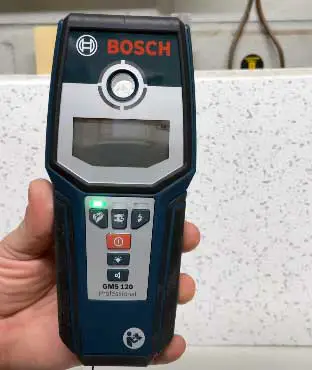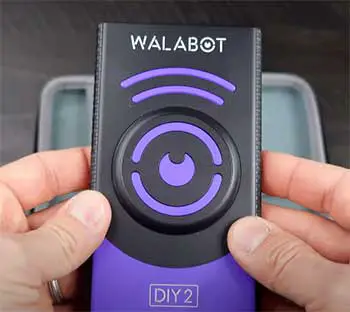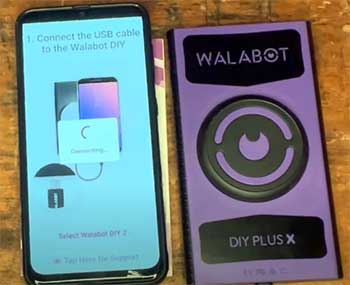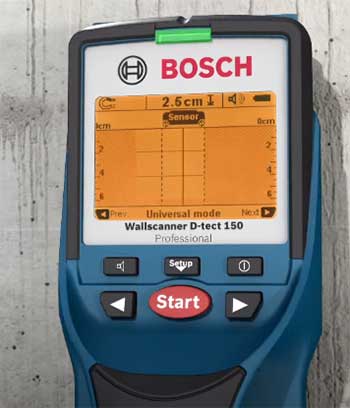When undertaking home improvement projects, knowing the location of structural elements like wall studs and pipes hidden behind drywall is critical. But for DIYers lacking X-ray vision, determining the layout of what lies beneath the surfaces poses a significant challenge.
Wall scanners provide an invaluable solution, using advanced technology to detect objects within walls without damaging materials or requiring extensive equipment. Handheld models designed specifically for home use allow you to harness subsurface scanning capabilities to maximize insight and safety for your DIY endeavors.

Two of the most popular options on the market are the Walabot DIY and Bosch D-Tect 150 wall scanners.
Both utilize advanced technology – radio frequencies and radar respectively – to see behind walls.
But with differences in features and capabilities, making an informed choice between the Walabot and Bosch requires detailed side-by-side comparison.
Below we will analyze the key similarities, differences, pros and cons of each model to determine the best choice depending on your needs and preferences as a home DIY warrior.
A Brief Comparison Table
| Feature | Walabot DIY | Bosch D-Tect 150 |
| Technology | Radio frequency field | Microwave radar pulses |
| Detection Capability | Studs, pipes, wires, rodents | Studs, joists, metals |
| Maximum Scanning Depth | 4 in (10 cm) | 0.75 in (1.9 cm) wood <br/> 1.5 in (3.8 cm) metal |
| Mapping Interface | Visual on Android app | LED indicator lights |
| Materials Scanned | Drywall, masonry, concrete, wood, plastic, ceramic | Drywall, wood, plaster, ceramic tile |
| Learning Curve | High (calibration complex) | Low (simple LED usage) |
| Ease of Use | Moderate (relies on mobile device) | High (dedicated device) |
| Portability | Moderate (requires mobile device) | High (integrated unit) |
| Battery Life | 1-2 hours (built-in rechargeable) | 20+ hours (AA replaceable) |
A First Glance View of the Walabot and Bosch
Before digging into specifics on performance and capabilities, let’s briefly introduce the devices and primary attributes.
Walabot DIY
- Portable wall scanner using radio frequency field technology
- View detected studs, pipes, wires etc through app on paired Android device
- Scans through various wall materials up to 4 inch (10cm) depth
- Designed for home improvement/DIY consumer market
Bosch D-Tect 150
- Handheld wall scanner utilizing radar technology
- Specifically built for stud, joist and metal detection
- Easy-to-understand LED display of hidden objects
- Targeted to casual and professional renovation applications
Similarities
Both the Walabot DIY and Bosch D-Tect 150 represent next-gen improvements on traditional stud finder methods, using advanced technologies to see within walls and eliminate guesswork pinpointing structural components and objects.
They are compact and easily portable designs intended for regular consumers and DIYers to incorporate into their home projects. Plus, they pose no risk to walls with their non-invasive scanning functionalities.
Differences
The key differentiator is the Walabot’s radio frequency field imaging capability which reveals a complete picture of what lies inside the walls. This allows identification of not just studs but also pipes, wires, nest critters and more during your scans.
Meanwhile the Bosch aims specifically to guide users to stud locations through an easy-to-decipher LED interface. It provides a dedicated precision stud finding experience eschewing bells and whistles.
Walabot DIY Detailed Product Discussion

Let’s explore the Walabot DIY stud finder’s features, use cases and capabilities in greater depth…
The Walabot harnesses radio frequency field technology, which allows sending safe low energy RF signals through solid objects.
The signals bounce back creating reflections that paint a picture of the density and location of the objects behind walls and other structural barriers.
Walabot processes these reflections to generate intuitive images showing pipes, wires, studs and even rodents hiding within your walls. This visualization then displays on a paired Android smartphone or tablet (no iOS support unfortunately) as you scan a wall using the Walabot scanner accessory.
Key Specs and Components
- Imaging Technology: Radio Frequency Field coupled with proprietary algorithms
- Paired Devices Needed: Android 5.0+ smart phone or tablet (no iOS)
- Detection Depth: Up to 4 inches (10cm) for studs; 2 inches (5cm) for pipes
- Batteries: Rechargeable built-in Li-ion; up to 1.5 hours operating life
- Materials Scanned: Drywall, plaster, concrete, wood, brick, stucco, plastic & fiberglass
- Detection Accuracy: Claimed to have precision within 2mm margin of error
- Usage Modes: Studs, Raw, Energy
- Extras: Walabot app with configurable settings; Charging dock station
Why Choose The Walabot Stud Finder?
The Walabot DIY makes an ideal wall scanning companion for home improvement devotees tackling remodeling or renovation projects. It empowers you to literally see through walls with X-ray-like vision using innovative radio frequency technology paired with your Android smartphone.
Benefits And Advantages
- Safely scan inside old walls to detect pipes and wires before drilling/cutting
- Locate studs, joists and attachments precisely before mounting heavy objects
- Map out locations of plumbing access points without needing blueprints
- Detect pest nests, hive infestations, structural anomalies behind walls
- Gain insights on potential material issues inside walls non-destructively
- Use Raw mode for full analysis to guide inspection or future wall work
You can harness these valuable subsurface insights to significantly de-risk your projects involving nails, screws and drilling into unknown wall innards. Plus the Walabot helps craft accurate plans for remodeling or renovation work by revealing hidden structural details.
Capabilities And Results

The standalone Walabot handheld unit connects to Android devices via USB to enable subsurface scanning powered by the application.
Device positioning is important to aim the built-in antenna properly towards the scanning surface.
You calibrate scan parameters through sensitivity tuning, target depth and filtering on what objects to show or hide (studs, pipes, wires etc.).
The app displays a visual mapping of objects in your walls with relative position and size.
This allows accurately locating studs for mounting flatscreen TVs or heavy mirrors and mapping out live wires and pipes when renovating kitchens and bathrooms. It also lets homeowners inspect for termite infestations, water damage issues, or HVAC air leak clues behind walls and ceilings without needing to smash holes during preliminary investigation.
The Walabot’s RF field technology can penetrate around 4 inches deep through drywall, masonry, plaster, wood, brick, fiberglass and other solid materials. Deeper scans are possible but reduce accuracy.
The biggest advantages over traditional stud finders are reliable detection despite wall materials, no direct contact need with the surface, and visual mapping guidance.
Usage and Projects
- Hanging artwork, mirrors, televisions by precisely locating studs
- Mapping old home renovation plumbing scope by detecting pipes
- Running new wiring by viewing paths of existing electric lines
- Inspecting for potential leaks, mold or critter infestations safely
- Performing quick investigations on questionable shower tile jobs
- Future-proofing smart home upgrades by scoping wiring configurations
The Walabot certainly involves a learning curve getting the calibration settings tuned properly for your project goals. But once mastered, the visualization payoff and insights gained safely mitigate many unknowns when working on both small household jobs and whole-home remodeling endeavors.
Bosch D-Tect 150 Detailed Product Discussion

Shifting focus to the Bosch D-Tect 150, this radar-based scanner takes a different approach to displaying detected objects behind walls…
Bosch designed the D-Tect 150 model wall scanner specifically and exclusively for stud detection.
It uses microwave pulse radar technology, which measures density changes to identify stud, joist and even live wire locations hidden behind walls.
LED lights with left/right directional indicators activate based on detected edges. This allows users to trace the endpoints and centers of framing elements for precision marking and measurement.
Although not as broadly capable as the Walabot DIY, the streamlined stud-finding focus matched with easy to decipher LED interface makes the D-Tect 150 a compelling solution for many common scenarios DIYers and renovators face around the home.
Key Specs and Components
- Detection Technology: Radar (microwave pulses)
- Integrated Display: LED signals with directional indicators
- Detection Depth: Up to 19mm (0.75”) for wood; 38mm (1.5”) for metal/wires
- Power Supply: 2x AA alkaline batteries (20+ hour life)
- Materials Scanned: Drywall, solid wood, plywood, plaster, ceramic tile
- Detection Modes: Stud Scan, Deep Scan, Metal Scan, AC Scan
- Measurements: CM/IN switchable
Advantages As A Stud Finder
Here are the core reasons to consider the Bosch D-Tect 150 if stud finding is your primary application:
- Ease of Use
The D-Tect 150 balances advanced radar technology with simple LED operation. Just slide the scanner along the wall and watch for the directional lights to trace stud edges. No calibration or settings adjustments needed.
- Dedicated Precision
By focusing specifically on stud location, the D-Tect 150 is engineered to maximize accuracy in pinpointing the framing elements within walls. The LED guidance allows for precise marking of stud center points.
- Intuitive Visual Display
The left/right LEDs virtually eliminate guesswork on where exactly the stud edges lie. The bright flash from centered green LEDs clearly indicates when you have passed over the middle of a stud for reliable markings.
- Wall Material Flexibility
The radar penetration capability allows stud finding for more wall materials beyond just drywall, including plaster, wood, concrete, ceramic tile and more up to a 1.5 inch depth.
- Affordability
As a dedicated stud finder, the D-Tect 150 avoids expensive advanced imaging complexities, while still enhancing performance over traditional magnetic and sensor stud detectors. This makes it an affordable bullseye solution.
- Capabilities and Results
The Bosch D-Tect 150 does a terrific job achieving maximum accuracy and ease of use for stud finding applications. Although not as broadly functional as Walabot, it focuses on excelling at the core need many DIYers share.
- Stud Detection and Tracing

Simply place and slide the D-Tect 150 vertically across your project walls, observing when the directional LEDs light up to trace stud edges.
Use the center point green LED flashes to accurately mark locations for your mounting needs.
The product conveniently includes built-in bubble levels to ensure keeping the scanner properly oriented as you work to maximize detection accuracy.
Plus there is a Deep Scan mode to extend the depth and sensitivity to find deeper set studs if standard mode struggles.
While viewing full mapped images of inside-wall contents provides confidence, the D-Tect 150’s LED display effectively guides your stud marking needs. And convenience features like auto power off and a belt holster for hands-free carrying benefit extended use cases.
Commonn Applications Include:
- Hanging artwork, mirrors or mountable televisions
- Installing wall-mounted shelving and cabinets
- Mounting accessories like cameras, speakers or light fixtures that require finding studs
- Starting points for leveling during framing, drywall and tile installation
For heavy duty mechanical, plumbing and electrical work, the Walabot’s pipe and wire detection certainly provides more helpful subsurface insights. But for routine needs locating studs, the Bosch D-Tect 150 stud finder allows executing projects effectively and with precision.
Side-By-Side Comparison Tables
Now that we’ve provided deeper dives on the specifics of each scanner model, let’s examine some key factors side-by-side:
Detection and Mapping Capabilities
| Aspects | Walabot | Bosch D-Tect |
| Technology Used | Radio Frequency Field | Microwave Radar Pulses |
| Stud Detection | Yes | Yes |
| Pipe & Wire Detection | Yes | No |
| Max Scanning Depth | 4 inches (10cm) | 0.75 inches (1.9cm) wood<br>1.5 inches (3.8cm) metal |
| Mapping Interface | Visual app display on Android device | LED indicator lights |
| Works Through Materials | Drywall, plaster, concrete, masonry, stucco, wood, plastic, ceramic | Drywall, wood, plywood, plaster, ceramic tile |
Convenience Factors
| Aspects | Walabot | Bosch D-Tect |
| Learning Curve | High (settings calibration complexity) | Low (simple LED usage) |
| Ease of Use | Moderate. Dependent on Android device. | High. Dedicated device. |
| Portability | Moderate. Relies on mobile device. | High. Integrated unit. |
| Battery Life | 1-2 hours (built-in rechargeable) | 20+ hours (AA replaceable) |
Key Differentiators
- The Walabot lets you visually map pipes, wires, studs, and anomalies providing a complete picture of wall internals
- The Bosch D-Tect 150 focuses specifically on tracing stud locations reliably using intuitive LED display
- Walabot requires fiddling with calibration settings but reveals more hidden objects
- Bosch D-Tect gives an easy dedicated stud finding experience out of the box
- Walabot must stay connected to phone/tablet while Bosch scanner is all-in-one
Frequently Asked Questions (FAQ)
For dedicated, precision stud finding functionality, the Bosch D-Tect 150 is hard to beat based on convenience and accuracy. But the more versatile Walabot allows identifying a broader range of hidden objects beyond just studs.
The Walabot Plus upgrades durability, battery life, and adds calibration-free functionality. However it loses the display screen in favor of LED signal-only directional guidance. So the Plus appeals more to pros than DIYers.
Without question, the Bosch D-Tect 150 provides unmatched ease of use for stud finding. Its self-contained design with intuitive LED display offers pick up and go stud tracing without a learning curve. Be ready to tinker more mastering the Walabot’s detection capabilities.
The Walabot comes closest to literally seeing through walls with its radio frequency scanning able to visually map studs, pipes and wires behind the surface. While the Bosch doesn’t show images, its radar LED signals reliably detect stud locations even through layers of materials.
Final Recommendations
Walabot – Home Improvement Warrior’s Dream Tool
If undertaking whole home remodeling projects or wanting maximum insights on your wall interiors, the Walabot DIY earns a full recommendation.
Convenience sacrifices are outweighed by the array of invaluable subsurface details discovered to empower your demolition, renovation and inspection needs while minimizing surprises.
Bosch D-Tect 150 – Precise Performer for Stud Finders
For those focused specifically on stud layout mapping for mounting televisions, shelves, etc, the Bosch D-Tect 150 provides foolproof plug and go stud tracing. Quickly start marking your wall project spots accurately regardless of material thanks to smart radar and intuitive LED display.
In the end, choosing between the Walabot and Bosch scanners aligns closely with just how extensively you plan to utilize the interior wall insights gained.
Casual users find outstanding reliability and convenience detecting stud locations with the Bosch D-Tect 150 as a precision instrument in its singular role.
But explorers at heart willing to trade some user-friendliness for exotic subsurface mapping functionality get an indispensable spelunking sidekick in the more expansive Walabot DIY. Let your project intentions and preferences for simplicity vs versatility guide you to the best fit.
Either way, embracing next generation wall scanning gadgetry leads to newfound perception and safer execution as you unleash your inner DIY warrior at home.

Your review was quite informative and helpful, but it is a little out of date. Currently the Walabot DIY 2 has 2 scan modes: Expert Mode – Displays the raw radar data & Image Mode – Displays graphical representations of wood studs, metal studs, and pipes/wires. Additionally it is now fully compatible with iOS and Android phones
Extended reach: Wi-Fi connectivity – work away from your phone
Built-in rechargeable battery – won’t drain your phone
Comes with USB Type C charging cable